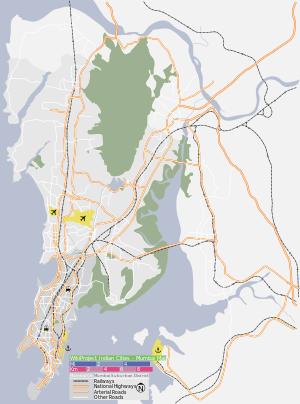Girgaum Chowpatty
| Girgaon Chaupati GIRGAON'S ATTRACTION | |
|---|---|
| Neighbourhood | |
|
Girgaon Chaupati during Ganesh Visarjan | |
 Girgaon Chaupati | |
| Coordinates: 18°57′04″N 72°48′40″E / 18.951°N 72.811°ECoordinates: 18°57′04″N 72°48′40″E / 18.951°N 72.811°E | |
| Country | India |
| State | Maharashtra |
| Metro | Mumbai |
| Languages | |
| • Official | Marathi |
| Time zone | IST (UTC+5:30) |
.jpg)
GIRGAON CHAUPATI' (Marathi:गिरगाव चौपाटी), commonly known as Chaupati (pronounced 'chow-patty'), is one of the best known public beaches adjoining Marine Drive in the Girgaon area of Mumbai, India. The beach is noted for its Ganesh Visarjan celebrations when thousands of people from all over Mumbai and Pune come to immerse the idols of Lord Ganesh in the Arabian Sea. It is also one of the many places in the city where the 'RAMLILA' is performed on a stage every year. An effigy of Ravan erected on the sand is burnt at the end of the 10-day performance. One can find several bhelpuri, panipuri, ragda patties and pav bhaji vendors on the beach.[1]
On the road running along the beach, the lone surviving terrorist of the 26/11 attacks, Ajmal Kasab, was caught and arrested. A bronze statue of Tukaram Omble, the policeman who helped arrest Kasab, was erected on 26 November 2011.
Etymology
Chowpatty is really Chau-pati (four channels or four creeks) as per (Bombay City Gazetteer, I. 27). This name is analogous to that of Satpaty, a village in the Mahim Taluka of the Thane District, which is approached through a Channel or Creek, containing seven divisions of water.
Pollution
The water surrounding the beach is heavily polluted, and swimming should be avoided. Fecal coliform was recorded in the water in 2013 at levels of 1455 per 100 mL, far above the acceptable standard of 500 per 100 mL. The presence of fecal coliform in the water has been attributed to waste from storm drains, open defecation, and the discharge of raw sewage from sewer pipes not connected to the city mains.[2]
On August 30, 2016, the sand on the beach is said to be turning black due to a possible oil slick in the area. The specific cause of the blackening is unknown.[3]
Images
.jpg) Girgaum beach with Nariman Point skyline in the background
Girgaum beach with Nariman Point skyline in the background Girgaum beach with Malabar Hills in the background
Girgaum beach with Malabar Hills in the background Corn cob vendors on Girgaum chowpati
Corn cob vendors on Girgaum chowpati View of Girgaum Chowpatty from Malabar Hill
View of Girgaum Chowpatty from Malabar Hill
References
- ↑ "All's bhel that ends well". timesofindia.com. Retrieved 11 April 2016.
- ↑ "Mumbai's coastal waters go from bad to worse". timesofindia.com. Retrieved 11 April 2016.
- ↑ "Why the sand at Mumbai's famous Girgaum chowpatty is turning black | Latest News & Updates at Daily News & Analysis". 2016-08-30. Retrieved 2016-08-30.
External links
| Wikimedia Commons has media related to Girgaum Chowpatty. |

